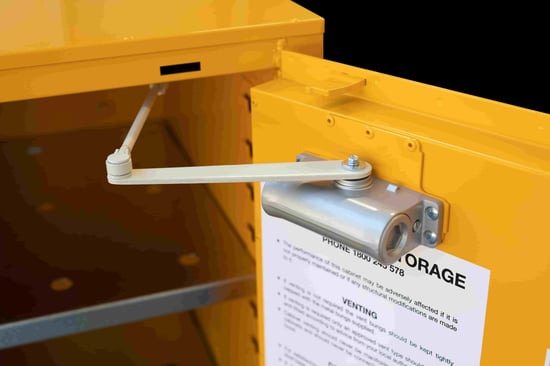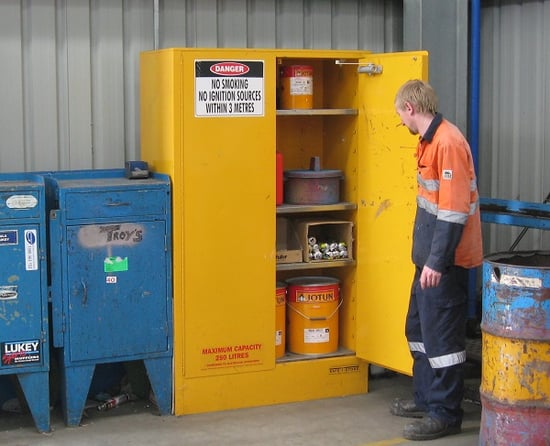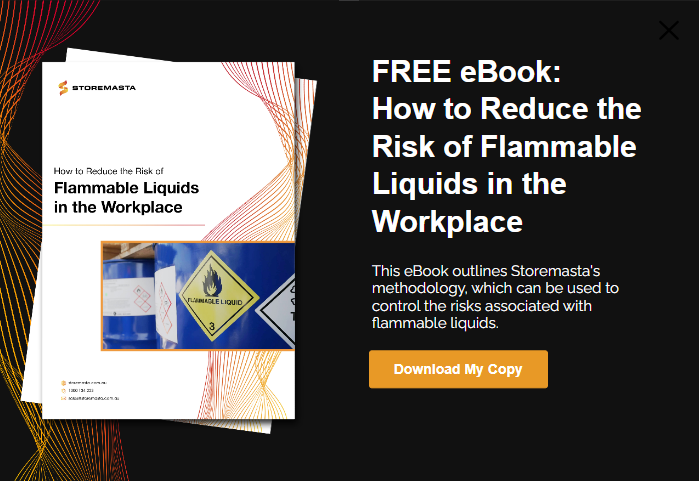Have you been searching for an answer to the question, ‘Do flammable cabinets need to be self-closing?’ It’s a common query that we hear often from customers who are considering the features of safety storage cabinets. But what are the specific requirements and regulations when it comes to self-closing doors on flammable cabinets? In this blog, we’ll look at the purpose and features of a flammable storage cabinet to find out how self-closing doors can affect the compliance of your workplace.
What Is The Purpose Of A Flammable Cabinet?
This type of safety cabinet has been specially designed and constructed for the indoor storage of Class 3 Flammable Liquids.
For those of you who are unsure what a flammable liquid is, they are liquids that have flash point below 60 °C. This is the temperature that the liquid has to reach before it ignites in the presence of an ignition source — such as a welding flame, glowing ember, electric motor, electric switch or lightning.

Your flammable cabinet is specifically designed to protect your flammable liquids from ignition sources, incompatible chemicals and impact damage.
The purpose of a flammable storage cabinet is to provide the following risk control measures for the workplace:
- Protect the flammable liquids inside the cabinet from damage.
- Provide segregation between incompatible chemicals.
- Chemical spill containment.
- Fire protection that protects the contents of the cabinet and allows a 10-minute window for people to escape the premises or utilise firefighting equipment.
To ensure that flammable liquids storage cabinets achieve these specific objectives, Standards Australia developed a standard that outlined the design and construction requirements for flammable liquids storage cabinets. This standard is called AS 1940:2017 - The storage and handling of flammable and combustible liquids.
Section 4.9.2 of this standard states:
“The cabinet doors shall be self-closing, close-fitting and held shut automatically by catches at two or more points”
So, when referring to the requirements outlined in the Australian Standards, the doors on flammable liquids storage cabinets must be self-closing.
If you happen to be storing flammable liquids in a dangerous goods storage cabinet that doesn’t have self-closing and self-latching doors, there is a risk that you will be financially liable due to non-compliance. You’ll also be risking a range of potential hazards that can result from a cabinet not carrying these features. We’ll explain more about this important risk control measure in the next section of the blog.

According to the Australian Standards, self-closing doors are a requirement for flammable liquids cabinets.
How Do Self-Closing Doors Make Flammable Storage Cabinets Safe?
Self-closing doors automatically shut once the doors of the cabinet have been released by the staff member that’s using the cabinet. This self-closing feature allows the cabinet to achieve the risk control measures that we’ve previously mentioned, such as segregation for incompatible substances and fire protection for the contents of the cabinet.
When the doors of flammable liquids storage cabinets are open, it hinders them from achieving their performance objectives — negating the design and purpose of the flammable cabinet.
REMEMBER: It’s important for staff, supervisors and contractors to be fully trained on how to use and maintain the flammable liquids cabinet. Cabinet doors must never be propped open by staff as this stops the cabinet from providing an effective risk control measure for your workplace.
We’ll now discuss the various ways that the cabinet’s self-closing door feature assists in keeping businesses safe and compliant.
Protect Contents From Damage and Contamination
In the workplace, there are many things that could cause packages of flammable liquids to become contaminated or damaged.
For example, if the fork tines of a forklift accidently hit a drum of flammable liquids, they can easily burst the package and the flammable liquids would leak into the workplace. Another issue is how much dust can be produced in a workplace. If this dust mixes with the flammable liquids, the chemical will become contaminated — and will therefore no longer be usable.

Flammable liquids that are stored in a compliant cabinet have a lower risk of damage or contamination.
Your flammable liquids storage cabinet will only be able to protect your contained chemicals from damage or contamination if the doors are shut.
The self-closing doors allows staff to retrieve packages, with the doors closing automatically as soon as they have been released. This functionality of the cabinet ensures that there is little risk of the stored packages being damaged or contaminated.
Providing Segregation From Incompatible Substances
There are many dangerous substances that are incompatible with flammable liquids.
When these incompatible substances mix, they can cause violent chemical reactions that increase risk to people, property and the environment.
Some dangerous goods classes that are incompatible with flammable liquids include:
- Class 5.1 Oxidising Agents
- Class 5.2 Organic Peroxides
- Class 6 Toxic Substances
- Class 8 Corrosive Substances
While the doors of the flammable liquids storage cabinet are shut, the cabinet provides perfect segregation from other incompatible classes of dangerous goods.
However, if the cabinet doors are left open, flammable liquids and vapours could flow out of the cabinet. This presents the risk of flammables mixing with other incompatible classes of dangerous goods.
Self-closing doors ensure that the doors of the cabinet are always shut when packages are not being retrieved from the cabinet. This lowers the risk of flammable liquids mixing with other incompatible classes of dangerous goods.
Contain Flammable Liquids Spills
One of the most serious workplace risks involving the storage of flammable liquids is the potential for a chemical spill.
Any spill or leak of flammable liquids can result in hazardous vapours escaping into the workplace. These vapours can cause a range of hazards including human harm due to asphyxiation.
 Compliant cabinets are designed to reduce the risk of chemical spills.
Compliant cabinets are designed to reduce the risk of chemical spills.
If these flammable vapours come into contact with an ignition source, a fire could be started. This can cause damage to people and property. Another issue associated with flammable liquid spills, is that the chemical could reach the natural environment and cause a pollution problem. It is because of these significant risks that flammable cabinets are designed with spill containment measures.
There is more possibility for flammable containers or packages to be knocked over and spilt if the doors of a flammable liquids storage cabinet are left open. The self-closing, self-latching doors also assist with the direction of spilt chemicals into the spill containment sumps, which is located at the bottom of the safety cabinet.
By keeping the doors closed through this automatic mechanism, your cabinet works more effectively as a spill containment solution — minimising both the potential for and impact of chemical spills and leaks.
REMEMBER: You must regularly inspect, maintain and clean out the spill containment sump of your flammable cabinet. If you allow chemical spills and leaks to sit in the sump, you are negating the effectiveness of the cabinet as a spill containment measure.
Insulation From Workplace Fires
Australian Standard AS 1940:2017 states that all flammable liquids storage cabinets must have a dual-skinned sheet metal construction with a 40mm air gap between two walls.
The purpose of this dual-skinned construction is to provide the cabinet with insulation and fire protection.
If a fire erupted in the workplace, unprotected flammable liquids could instantly ignite — which would only intensify the blaze and release hazardous chemicals into the workplace.
However, by choosing to store your flammables in a compliant cabinet, you are giving yourself a 10-minute window of time to either evacuate workers or contain the fire with firefighting equipment. If the doors of the cabinet were left open, the insulative properties of the cabinet would be negated and the flammable liquids would be susceptible to ignition.
The self-closing, close-fitting doors are a crucial feature of the flammable liquids cabinet and offer an important risk control measure for workplaces.
Does Your Flammable Cabinet Have Self-Closing, Close-Fitting Doors?
We hope you now have a better understanding of the importance of self-closing doors for your flammable cabinets. Because of the serious risks that Class 3 Flammable Liquids pose to workplaces that carry them, it’s vital that you store these chemicals in compliant flammable liquids storage cabinet — complete with self-closing doors, of course. If you would like to learn more about reducing the risks associated with storing flammable liquids, our Dangerous Goods Storage Specialists are here to help. We’ve created an easy-to-read eBook to help you learn more about the safe and compliant storage of flammable liquids. Why not access our free eBook, How To Reduce The Risk Of Flammable Liquids In The Workplace, for free today?

Living life by the 4 C’s of marketing – communication, coffee, compliance… and more coffee – Leisa Andersen is Storemasta’s Content Marketing Manager. When she’s not writing, you’ll find her enjoying all the good things in life, including shopping, travel and gluten free donuts.
